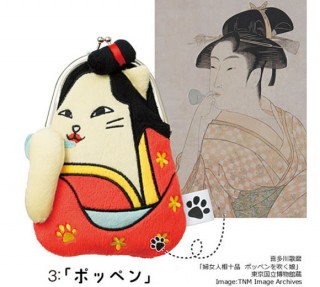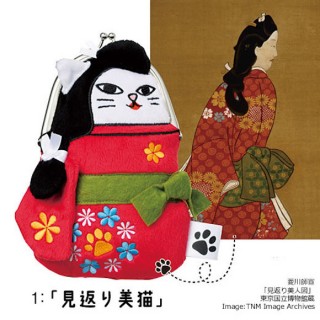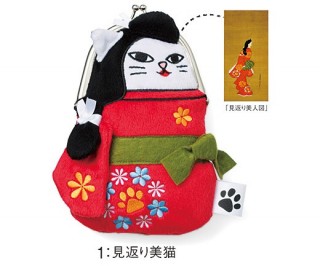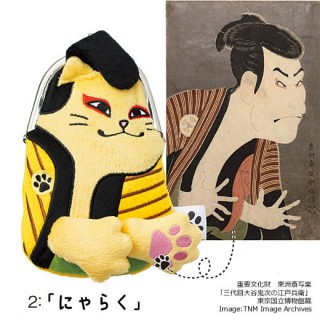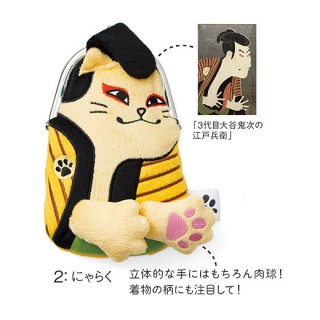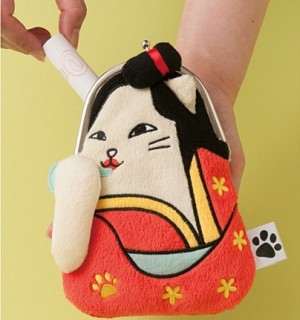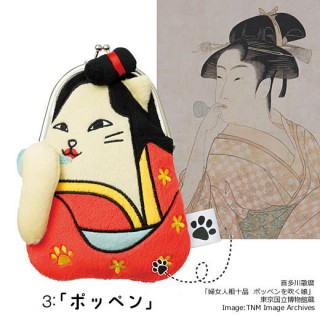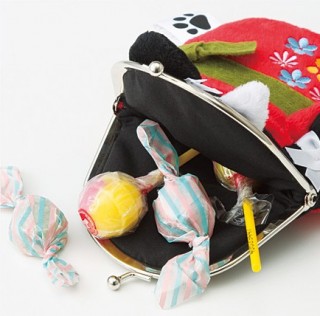Loading
Search
▼ Kabuki And Geisha Cats Appear As Cute Purses Based On Famous Japanese Ukiyo-e Woodblock Prints
- Category:Souvenir
Edo-period artwork gets the cute cat treatment in Japan.
Japanese online retailer Felissimo, which has a whole department dedicated to cat-themed goods, recently added three unusual kittens to their ever-growing collection. Appearing in traditional garb, but retaining feline features, these cats are actually purses taking style cues from famous ukiyo-e woodblock prints from the Edo period (1603 – 1868).
First up, we have a kitty based on a piece called the “Mikaeri Bijin” (Beauty Glancing Back), which was painted by Hishikawa Moronobu (1618-1694), who was known as the “father of ukiyo-e” and mostly painted kabuki scenes and beautiful prostitutes.
Called the “Mikaeri Bineko”, which translates to “Beautiful Cat Glancing Back”, the white hair ties and green obi sash details are dutifully replicated on the clip-top purse. The orange, blue, and white flowers also appear on the red kimono, with the cute addition of a paw print in the design.
Called the “Mikaeri Bineko”, which translates to “Beautiful Cat Glancing Back”, the white hair ties and green obi sash details are dutifully replicated on the clip-top purse. The orange, blue, and white flowers also appear on the red kimono, with the cute addition of a paw print in the design.
Next up, we have a painting from 1794 known as “Otani Oniji III in the Role of the Servant Edobei”, painted by Tōshūsai Sharaku, whose real identity remains a mystery to this day. Active for only ten months between 1794 and 1795, some believe the artist could have been a Noh actor, a little-known poet or perhaps even the famous ukiyo-e master Katsushika Hokusai (c.1760-1849). Despite his short active period, the artist made over 140 prints, mostly of kabuki actors, throwing the public off balance with a realism that often captured the subject’s unflattering details.
However, there’s nothing unflattering about this kitten, especially since he’s showing off a cute, pink paw-pad in the dramatic style of Otani Oniji III. Called “Nyaraku”, a play on words which puts Sharaku, the artist’s name, alongside “nya” an abbreviation of the Japanese word for “meow”, this cat wears stylised kabuki makeup and a cat paw as a family crest.
The last Edo-styled kitten to join the lineup is called “Poppen”. Based on the famous ukiyo-e “Poppen o Fuku Musume” or “Young Lady Blowing on a Poppen” by Kitagawa Utamaro (c.1753-1806), the beauty’s feline doppelgänger wears a big smash of red lipstick and a fancy, red-ribboned top-knot. In her hand, she holds a poppen, a glass bauble toy popular with geisha during the Edo period. When blown at its flat end, the toy would make a popping sound, similar to a whistle.
▼ While the purse can be used to hold coins, its shape makes it more suited to holding small personal items like lip gloss…
However, there’s nothing unflattering about this kitten, especially since he’s showing off a cute, pink paw-pad in the dramatic style of Otani Oniji III. Called “Nyaraku”, a play on words which puts Sharaku, the artist’s name, alongside “nya” an abbreviation of the Japanese word for “meow”, this cat wears stylised kabuki makeup and a cat paw as a family crest.
The last Edo-styled kitten to join the lineup is called “Poppen”. Based on the famous ukiyo-e “Poppen o Fuku Musume” or “Young Lady Blowing on a Poppen” by Kitagawa Utamaro (c.1753-1806), the beauty’s feline doppelgänger wears a big smash of red lipstick and a fancy, red-ribboned top-knot. In her hand, she holds a poppen, a glass bauble toy popular with geisha during the Edo period. When blown at its flat end, the toy would make a popping sound, similar to a whistle.
▼ While the purse can be used to hold coins, its shape makes it more suited to holding small personal items like lip gloss…
▼ …or perhaps even a secret stash of candy.
If you’d like to hold a precious painting with cat features in the palm of your hand, these purses are available online for 2,133 yen each (US$18.20). As always, a portion of the sale price goes to the Felissimo cat fund, which works to care for animals without owners and provide assistance to foster pet programs.
- February 13, 2016
- Comment (0)
- Trackback(0)


